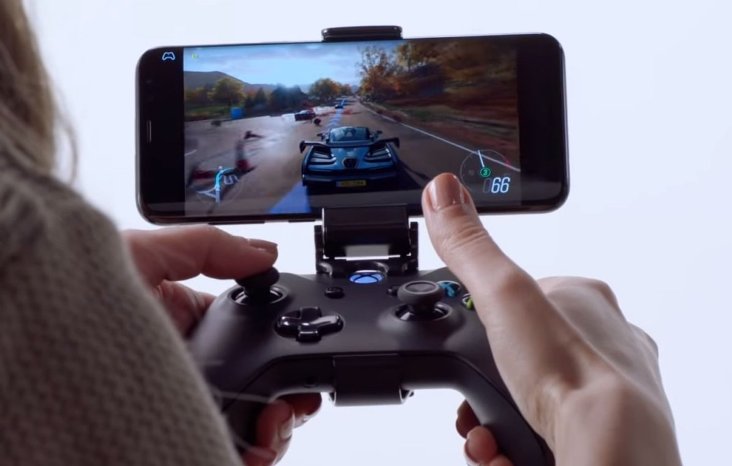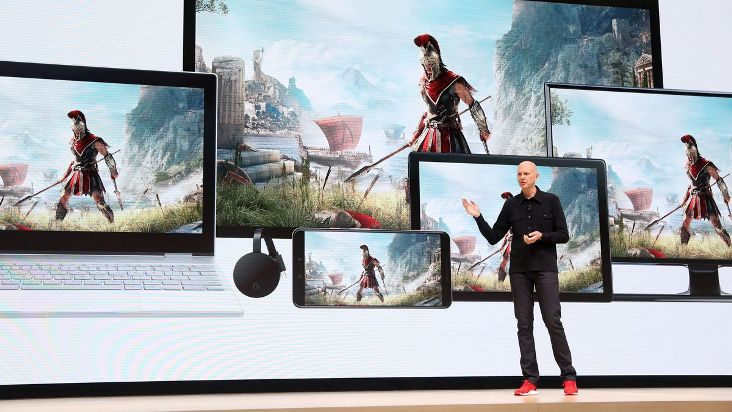Playing a video game is no longer limited to popping a disc in your console and pressing the power button. Instead, we now have digital downloads and more recently, game-streaming services that let you instantly begin playing the latest titles without having to install or purchase individual games.
Two of the biggest upcoming game-streaming services – Google Stadia and Microsoft’s Project xCloud – are on the horizon, and both promise unprecedented freedom and ease-of-use for players. They’re sure to offer each other competition, but when it comes down to Google Stadia vs. Project xCloud, which is shaping up to be the more impressive service?
There will be no dedicated console or box needed to play games on either Google Stadia or Project xCloud, but the two services won’t work identically, either. Depending on the systems you own, one could seem like the better choice, especially if you have a preference in the games you play.
Google Stadia is designed to run through your Chrome web browser. During initial tests as “Project Stream,” it could be used only on desktop computers, but when the final version of Stadia is live, you will be able to use it on devices like phones and tablets as well. Because it uses your Google account, this theoretically means you’ll be able to stop playing a game on your PC and start playing on your phone in mere moments.

Project xCloud doesn’t look to offer quite this level of seamlessness, but because the technology is built on the existing Xbox infrastructure, you will be able to carry all of your cloud saves and data across the devices you use for xCloud and your other Xbox games. If you play a game on your Xbox One at home and then leave for a week, you should be able to enjoy it via streaming from your phone while you’re gone.
Controllers
Google Stadia’s freedom-of-choice approach continues for the controllers the platform will use. You are free to use several different popular game controllers you already own, including the PlayStation 4’s DualShock 4 and Microsoft’s own Xbox One controller and Xbox Adaptive Controller. Mouse-and-keyboard is also supported.
However, for more platform-specific interactivity, you can use the Google Stadia controller. In terms of form factor, it’s somewhere between the Xbox and PlayStation options, with similar face button and stick layout, and comes with a share button. It also includes a Google Assistant button which allows you to speak into a microphone and get tips for your games on the fly. The Google Stadia controller will be connected to the platform via Wi-Fi.
Project xCloud works a little bit differently. Using a Bluetooth connection, you can pair a standard Xbox One controller with your device of choice and play the games using the same control scheme you would have on your Xbox console – in demonstrations, the controller is mounted to a phone to do this. However, games will also have specially-designed touch control interfaces for those who don’t want to carry a controller with them. We saw Sea of Thieves using this input type during a demonstration, and it mapped actions to virtual buttons on the screen.
Streaming Quality
Google and Microsoft are not promising the same streaming quality on their services, at least when it comes to resolution. This is hardly surprising, as Microsoft’s Xbox consoles continue to be its go-to destination for 4K and HDR gaming.
At launch, Google Stadia will support 4K gaming with HDR and 60 frames per second, and will lower down to 720p resolution for those with slower internet speeds. In the future, it could get up to 8K resolution and 120 frames per second. The GPU Google is using in its data centers allow for up to 10.7 TFLOPS of power, which is nearly double what the Xbox One X is capable of. To run games at 4K, players will need 30 Mbps or higher in internet speed. During our tests of Project Stream, we found the quality of Assassin’s Creed Odyssey to be good, but not as impressive as if it had been running on a console.
Using the “Stream Capabilities API” included in what Google has dubbed the “Playability ToolKit,” developers will have live access to a player’s stream capabilities, including HDR, surround sound, and resolution. This will allow them to adjust game settings on the fly, providing the best possible settings for players.
Additionally, Product Manager Khaled Abdel Rahman addressed latency concerns with Stadia at Google I/O, saying the team has weekly research sessions in addition to wider scale testing. The team is focused on trying to find a balance that works with the many inconsistent factors in each player’s situation.
Microsoft has not shared specifics regarding resolution targets for xCloud, but it will be leveraging its own 54 Azure data center regions to power the service. Because of the local Bluetooth connectivity, and assuming the service has low latency, it should provide players with an experience comparable to what they get on the Xbox One or PC.
What players might not get, however, is an experience on par with the upcoming PlayStation and Xbox systems. According to 3D Realms VP Frederik Schreiber, the PS5 and Xbox “Anaconda” systems will be far more powerful than Stadia in particular. It remains to be seen if this is actually the case, but with the PS5 confirmed to support ray tracing and 8K resolution already, it seems likely that it is.

Games
Google Stadia will have several third-party games available when it launches. Among these are multiple Ubisoft games like Trials Rising and the upcoming Skull & Bones, as well as Doom Eternal from Bethesda. Developers can sign up to apply for Stadia development on the official developer website. Stadia will support multiple game engines, including popular choices like Unreal and Unity.
We also know something is in the works from major independent developer Q-Games, and it will make use of the service’s “State Share” feature. However, we don’t know what the game will be or even its genre. Rime studio Tequila Works was featured during the announcement presentation, as well, so it will likely have involvement.
Alongside third-party games, Google is also jumping head-first into game development with Stadia. Former Electronic Arts and Ubisoft producer Jade Raymond will lead Stadia Games and Entertainment, a first-party studio dedicated to producing exclusive titles for the platform.
Project xCloud won’t be getting exclusive games, at least not ones that aren’t also available on Xbox consoles and PC. This means you’ll be able to enjoy the same games as someone playing Xbox games on a console or PC and vice versa. If you are choosing a service based on which will offer you more unique experiences, Google Stadia looks to be the early winner here.
That being said, Microsoft is bolstering its first-party game development studios, with recent acquisitions of Obsidian Entertainment, Ninja Theory, Compulsion Games, and Playground Games, as well as the establishment of The Initiative. We will not see the fruits of these studios’ labor quite yet, but it points to exciting possibilities in a few years.
Features
Google Stadia is designed to create a more organic and symbiotic relationship between game developers, content creators, and players, with a series of tools to enhance games – both during their creation and afterward.
Developers will have access to the Style Transfer ML feature for environmental design, which could cut down on the time it takes to add skins or textures to play areas. During a demonstration at GDC 2019, we saw the AI-powered tool add several different textures to a black-and-white environment, effectively transforming it seamlessly.
Game developers and publishers will have an easier time getting their games into the hands of players, as well. When watching a YouTube advertisement for a game from a company’s official channel, there will now be a button you can click to instantly start playing the game. Because there is no download necessary, you can get from watching the video to playing the game in less than five seconds.
If a streamer is playing your favorite game on YouTube, you will be able to join them in their game, as well. Using Stadia’s “Crowd Play,” you can jump into the same game they are playing and even join their multiplayer session. Most excitingly, you can also jump into a version of the game with their save data and start exactly where they were.
Features like these have not been shared yet for Project xCloud, but Microsoft promises more details over the next few months. E3 seems like the most likely place for a new announcement to be made, particularly as Microsoft will be the only first-party console company to be holding a traditional press conference this year.
Availability and Price
Neither Microsoft nor Google have revealed the pricing structure for their respective streaming platforms yet. With Microsoft, we have the precedent of Xbox Game Pass, which typically costs $15 per month for access to a vault of games. We anticipate xCloud being priced similarly, as Game Pass also includes access to all first-party games on launch day.
Microsoft is planning public tests for xCloud in 2019, but did not specify the regions in which it will be available. Google Stadia, meanwhile, will begin arriving to the United States, Canada, United Kingdom, and most of Europe in 2019.





